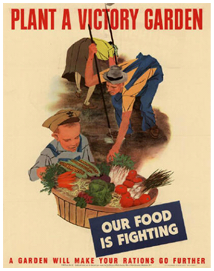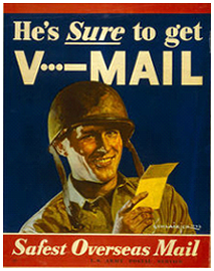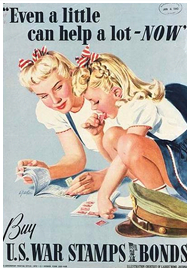



More than 15 million Americans—mostly men, but women, too—served in the armed forces during the war. Almost 400,000 never returned. Despite the strain, Americans were determined to keep up their morale (spirit and cheerfulness). The government urged the public not to complain and to think of the war effort before their own personal needs. Here are some of the things Americans did:

One of the government's efforts to make sure that there was enough food for everyone — civilian and military alike — was the campaign for Victory Gardens. The idea was that everyone could raise some fruit or vegetables. They were a way for people to feel patriotic and contribute to the war effort, and provided 40 percent of vegetables grown in the country during the war. There were almost two million Victory Gardens in America during the war, from suburban backyards to small city plots of land.


During the war, food was rationed because the troops had to be fed and most of the ships that carried goods were used for war supplies. People received ration books, which had coupons for certain items like sugar, coffee, butter, meats, and canned goods. The coupons allowed you to buy the item in the store. Even if you had the money, if you did not have a coupon, you could not buy that food! Rationing meant everyone got a fair share when there weren’t enough supplies. Besides food, clothing and gas were rationed too. Because of gas and rubber shortages, Americans were forced to do less driving. That meant that many homes had to be careful of how many times they went to the movies, went on picnics, or even to the store.
Download the rationing fact sheet!


Even though battles were not being fought on American soil, people at home prepared through the Office of Civilian Defense. Volunteers would keep a lookout for enemy planes. People also prepared their own homes and cars. In coastal towns, lights were either blacked out or dimmed so that enemy planes would not have a target at night. Windows were covered with dark materials like blankets so that light from the inside wouldn't show on the outside. Lampposts were painted black on their top so that the lights would only shine downward.
Download the civil defense fact sheet!


In 1944, 30 million homes had at least one radio — some had more than one. Without TV, newspapers brought the images of war back to the home front, but it was the radio that was the best source for the latest news. The radio was also a way for the government to stay in touch with the American public. President Roosevelt used the radio to his advantage by talking to the people directly in his famous "fireside chats."
Download the radios fact sheet!


One way in which all Americans could feel patriotic was in collecting materials needed for the war effort. Rubber, metal, and paper were some of the highest priorities. Kids would organize metal drives in their neighborhoods. They would collect old toys, old pots and pans, and even bottle caps off the street in order to make a small difference in the war effort. Paper was scarce too so everyone saved paper for recycling. Students would go door to door collecting scrap paper. They felt it was their patriotic duty.
Download the scrapping fact sheet!


V-mail, or Victory Mail, was a new invention for people writing letters during the war. Everyone knew how important it was to write your loved one when he or she was overseas. They were far away from home and often in danger for their lives, and a letter from home was a great boost for morale. Delivering letters to the front was not an easy task. The government promoted V-mail, which used film reels that were smaller for shipping than bulky paper, because it was cheaper while families liked it because of its speed.
Download the v-mail fact sheet!


Waging war costs money, and lots of it. In order to raise some of that money, the American government sold war bonds and stamps. If you bought a war bond for $18.75, it would be worth $25.00 ten years later. If you did not have $18.75 all at once, like most kids, you could buy war stamps. Each stamp was worth 10 cents, and you would paste each stamp into a book until they added up to $18.75. It became very patriotic to buy bonds and stamps. In fact, one of the most popular Christmas gifts during the war was a war bond!
Download the war bonds fact sheet!